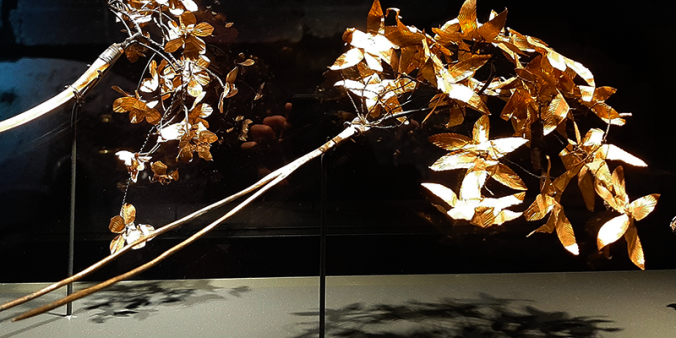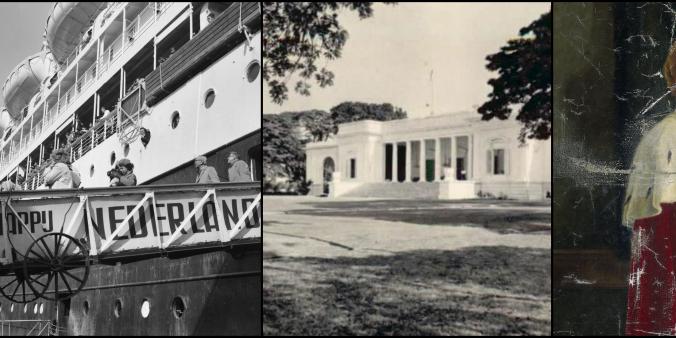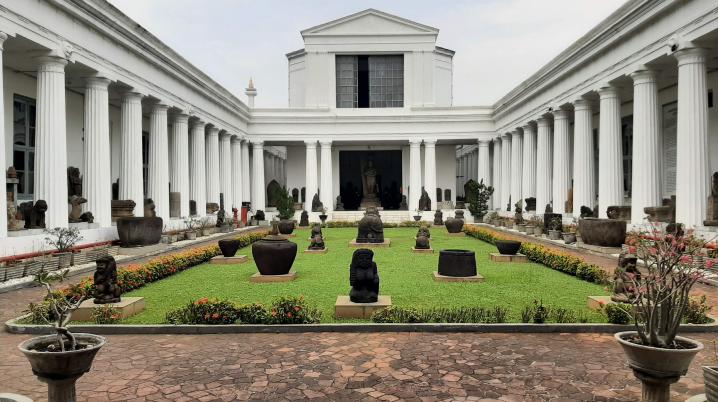
Return of objects celebrated, but now the Indonesian National Museum is ablaze
Indonesian historian Christopher Reinhart, with whom DutchCulture previously worked for three articles on the story of the Erasmus Huis, has written a background article based on the devastating fire in the National Museum of Indonesia in Jakarta of Saturday 16 September 2023. The In this article, he contemplates the value, or rather invaluable, nature of historical objects, on the return of historical objects from the Dutch national collection to Indonesia, and on the origins of the Indonesian National Museum, both the building and collection. Throughout Christopher’s contemplation, the cultural relationship between Indonesia and the Netherlands is a common thread, as both countries are intertwined, both historically and in the future. In the meantime, the National Museum has contacted the Dutch government to discuss the reconstruction of the devastated heritage building and collection management.
On Saturday night, 16 September 2023, at 20:50 hrs, my phone received an incoming call from a colleague, archaeologist Muhamad Alnoza. I thought he called me because of his usual questions about Buddhism, but my heart sank when I learned that he was calling for a different purpose. Without a greeting, he immediately exclaimed, "[I have] shocking news, the National Museum is on fire!". About forty minutes before that call (at 20:10 hrs), a passerby had noticed flames rising at the National Museum of Indonesia. When I turned on the television, the fire was already making headlines. As someone immersed in the field of history, my initial feeling was one of profound sorrow and loss. Indeed, as I am writing this article, the extent of the impact of the fire on the museum's collection of artefacts is yet unknown. There also is no news yet about the extent of damage to the museum building itself. Regardless, this is a significant loss, considering the Indonesian National Museum itself is a listed heritage building. Due to the ongoing investigation, technical lessons about museum security cannot be learned at this time. However, there are other lessons that we can draw from this.
The irreplaceable value of historical objects
Museums and their collections are not just important on their own. They are significant for many different disciplines and a much broader field of study: history, ethnography, natural sciences, architecture, design, and so on. Museums are important both as research object, and as institute where research is performed. In the first case, disasters that befall museums – such as the fire last night – are a severe blow to the work of historians. Historical objects are unique because they are tangible remnants of certain historical events. Historical events are by definition non-reproducible. The Java War (1825–30) led by Prince Diponegoro will not happen again, except perhaps in pattern (a war raging in Java). Consequently, the material remnants of that war become irreplaceable singular objects. There may be many other horse saddles similar to Diponegoro's saddle, but the horse saddle object displayed in the Gold Collection Room (on the fourth floor of the National Museum) is the only one. The same goes for keris (traditional Indonesian daggers), inscriptions, statues, or other artefacts. All of these may be replicated, but the value of these objects lies not in their physical attributes but in their historical value: their connection to events that have taken place in the past. The destruction or damage of an object that serves as a historical source can disrupt the work of historians in objectively investigating the past.
One colourful example that illustrates the irreplaceable value of historical objects can be found in Nunus Supardi's writing, Moh. Amir Sutaarga: Bapak Permuseuman Indonesia (2020:148–151). Supardi recounts the return of the Prajñāpāramitā statue from the Rijksmuseum voor Volkenkunde (National Museum of Ethnology in the Netherlands) to the National Museum of Indonesia in April 1978. The Prajñāpāramitā statue, better known as the ‘Ken Dedes statue’, originally found near Malang, was taken to the Netherlands in 1820. In the context of the improved bilateral relations between Indonesia and the Netherlands in the 1970s, this statue, which was renowned for its beautiful artistic style, was returned. What was intriguing is that this object held immense significance for the then-Director of the National Museum of Ethnology, Peter H. Pott. Before its return, the museum in Leiden had created four replicas of the statue, yet none of them were put on display. Supardi writes, "[...] but all of that [making replicas] could not erase his [Pott's] sadness, so for years, the replica statues were only kept in the depot [collection warehouse]". Another curator even testified that Pott would shed tears every time he looked at the replicas of the statue. This led to the four replica statues being dubbed "Pott's tears". This colourful testimony illustrates how an original historical object is impossible to replace in terms of its value.
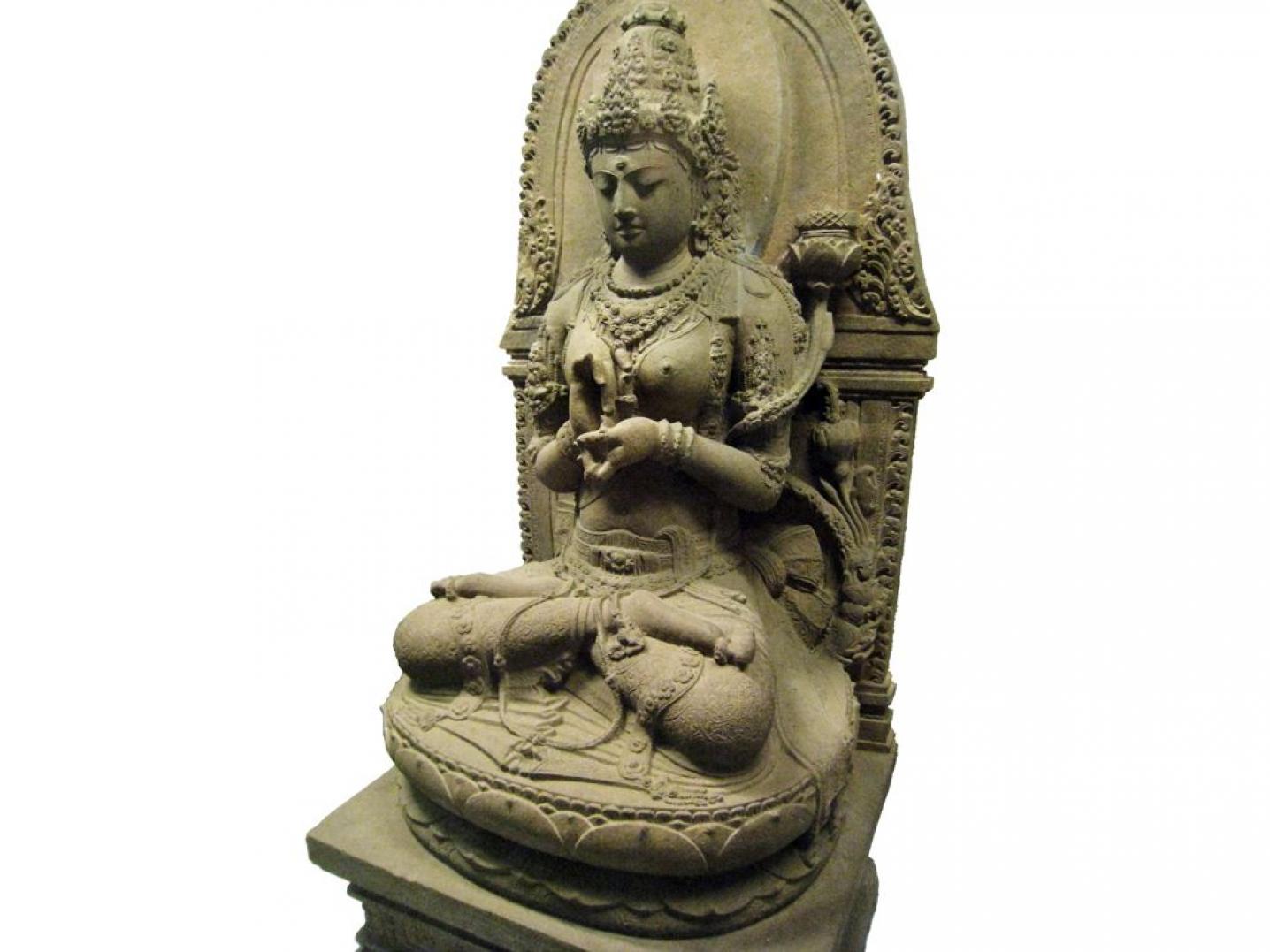
‘Do not put all your eggs in one basket’
The return of the Prajñāpāramitā statue in 1978 is one example of proto-repatriation efforts carried out between Indonesia and the Netherlands. This issue has gained even more prominence in the context of recent repatriation of objects from the Dutch national collection to Indonesia. These objects are cultural artefacts taken from the Indonesian archipelago unlawfully or through looting during the Dutch colonial period. To the occasion of the state visit of the Dutch King Willem-Alexander to Indonesia in 2020 the ‘Kanjeng Kiai Nogo Siluman’ keris originally owned by Prince Diponegoro was returned to the Indonesian government. In line with this precedent, the Netherlands government established the Advisory Committee on the Return of Cultural Objects from Colonial Context (hereinafter referred to as the Colonial Collection Committee), chaired by Lilian Gonçalves-Ho Kang You, to provide advice on the return of other Indonesian objects in the Dutch national collection. This led to the return of 472 objects to Indonesia in July 2023.
Among Indonesian academics and activists, the issue of repatriation of cultural objects has gained prominence. Although this issue is more prominent in the Netherlands than in Indonesia, diverse voices also contribute to the discourse in Indonesia. Some Indonesian academics believe that the museum infrastructure in Indonesia is not yet sufficiently capable of self-management, especially considering the impending addition of collections from the Netherlands. The latter argument may sound very colonial if voiced by someone from the Netherlands. Unfortunately, the last opinion seems to contain some truth. The recent fire at the Indonesian National Museum appears to be one of the haunting spectres that has become a reality.
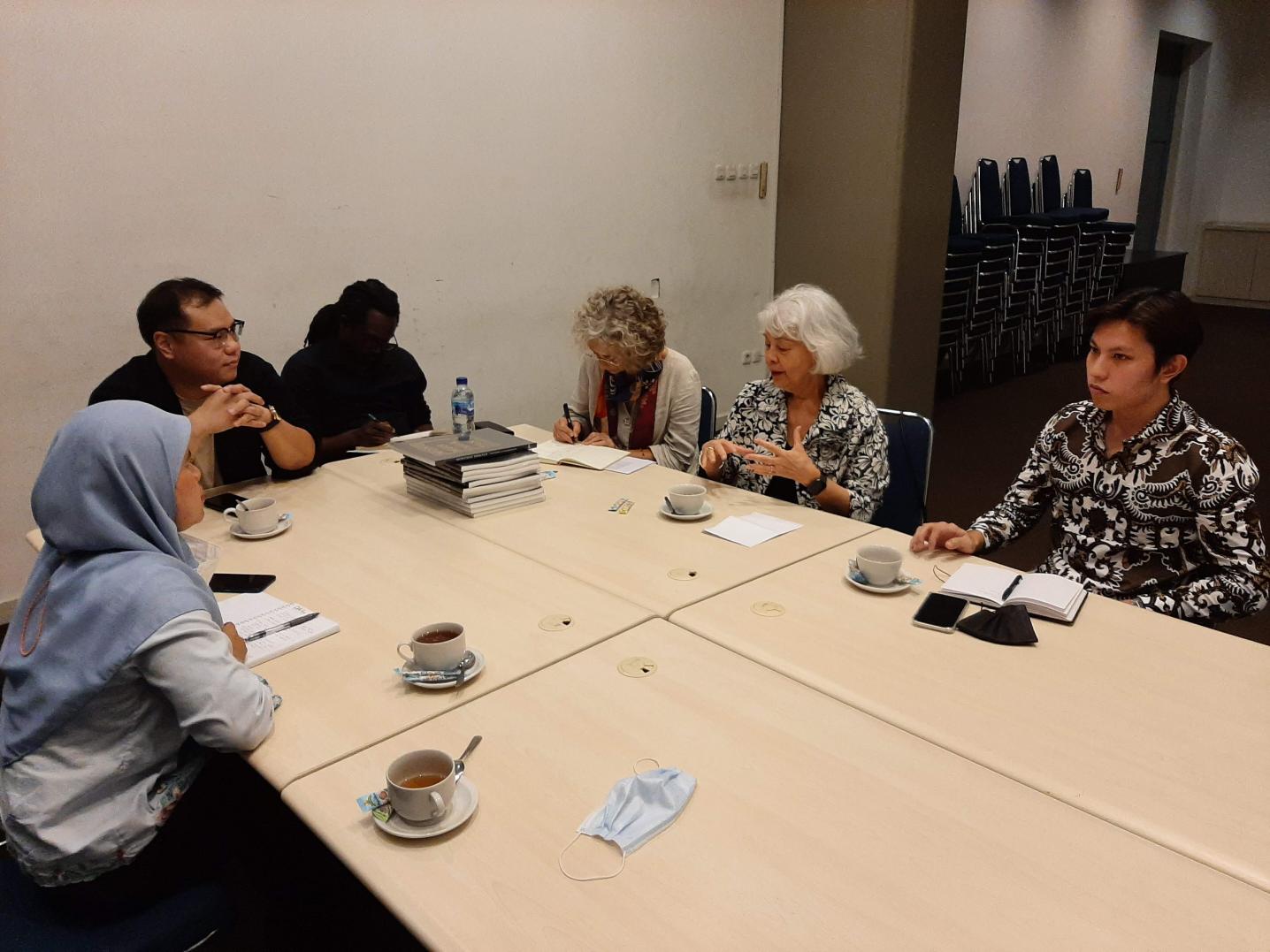
I had the opportunity to sit down with the chair of the Colonial Collection Committee on 14 September 2022, during a visit of the Dutch State secretary of Culture, Gunay Uslu. One of the other Indonesian museum professionals attending, Chairperson of the Association of Museums at Taman Mini Indonesia Indah, Rian Timadar, gave a very relevant suggestion: to distribute the collections returning from the Netherlands to Indonesian museums related to those collections. In this way, we would not be ‘putting all our eggs in one basket’, namely the Indonesian National Museum. Unfortunately, Gonçalves stated that such distribution falls outside the Dutch committee's jurisdiction. This suggestion should be directed to the Indonesian government. From the Dutch perspective, the return of objects is an intergovernmental matter: the Dutch government hands over the objects to the Indonesian government and the fate of those objects is then determined by the Indonesian government.
This idea does become somewhat complex to implement, considering that not all museums in Indonesia fall under the Ministry of Education, Culture, Research, and Technology (Kemdikbudristek). Meanwhile, the Indonesian national government’s counterpart in this matter is Kemdikbudristek. It may not be too late to convey this suggestion to the government. Within the framework of caution, I believe that the dispersion of Indonesian cultural artefacts to various locations in Indonesia or even abroad is a strategic approach to prevent the potential loss of all cultural artefacts in a single night. This may pose challenges for researchers seeking access to their sources. However, this issue could be addressed through the strengthening of digital infrastructure and collaboration among cultural institutions to ensure easy and affordable access to their collections for those seeking enlightenment.

The colonial origins of the Indonesian National Museum
The suggestion of ‘not putting all your eggs in one basket’ is certainly more challenging to apply at the National Museum compared to other museums in Indonesia. This is closely related to the origins of the National Museum, namely Royal Batavian Society of Arts and Sciences. The Batavian Society was founded in 1778 as an association of wealthy art enthusiasts. Its early members were officers of the Dutch East India Company (VOC) with a passion for art and cultural objects from the Indonesian archipelago and its surroundings, which they viewed as ‘oriental’ items. The Batavian Society's collection was highly diverse, encompassing various regions within the Indonesian archipelago. The association moved into the building that now houses the National Museum in 1862, nearly a century after its establishment. The Batavian Society's method of collecting artefacts eventually found resonance in the Indonesian Republic as its national museum, with a collection on a national scale. The method of collection of the Batavian Society was to actually ‘put all the eggs’ in one place. Considering this historical context, the previous advice might not be relevant. In this case, the only viable approach is to pay meticulous attention to museum security. Neglecting museum security risks losing the most critical material evidence of the history of the Indonesian archipelago's civilisations. The museum houses tangible evidence of many of the stories we encounter in our history textbooks, from the Amarāwatī Dipankara Buddha statue to some most important inscriptions, and even the keris and spears of Diponegoro.
As I mentioned at the beginning of this article, we do not yet know the extent to which the fire has impacted the collections of the Indonesian National Museum. Hopefully, few objects have been affected. However, if there are items that have been damaged or even fully consumed by the fire, a passage from Khaled Hosseini's novel A Thousand Splendid Suns (2007) is worth reflecting upon: "[...] like an art lover running out of a burning museum, she would grab whatever she could—a look, a whisper, a moan – to salvage from perishing to preserve. But time is the most unforgiving of fires, and she could not, in the end, save it all".
Christopher Reinhart is a researcher specialising in colonial history in Southeast Asia and Indonesia. He serves as a research consultant at the School of Humanities, Nanyang Technological University (NTU) in Singapore.
This article was originally published in Indonesian at Indonesian news outlet Kumparan.
